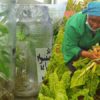Business
War on Striga ‘witchweed’ gets new ammunition

Striga Weed (with purple flowers) attaches to maize roots and kills the crop. The new maize variety kills the parasitic weed
Science has once again come to the rescue. After several years of battling the destructive effect of the invasive Striga weed, farming communities across East Africa and much of the Sub-Saharan region have a reason to smile after efforts to combat the pest received a major boost this week.
With support from the USAID funded Feed the Future Partnering for Innovation program, Kenya has announced plans to expand the production and distribution of StrigAway, a maize variety that is resistant to the weed.
The expansion comes after the variety proved successful in the control of the destructive weed that tends to kill the host plant. In Uganda Striga has already ravaged maize and Sorghum plantations especially in the Eastern part of the country, worsening poverty and food security in the region.
In Kenya, the introduction of Striga-resistant maize has helped to reclaim up to 20,000 ha of arable land that had been rendered unproductive because of the weed.
Until now, NASECO was the only seed company in Uganda selling StrigAway – under the trade name Kayongo-Go. The extension of the programme means that more seed companies can apply to get foundation seed to produce the Striga resistant maize seed for distribution to farmers. Victoria Seeds Ltd, has also been confirmed as the second company that will sell StrigAway.
AATF Executive Director Dr. Denis Kyetere described StrigAway as a major success with an increase in maize production recorded in Kenya from 20 million tons from the previous low of 8 million tons.
“AATF is proud to have driven this initiative that has improved food security for many households in the region,” said Dr. Kyetere.
But the challenge remains enormous, according to AATF officials as more than one million hectares of land within East Africa remains under Striga infestation.
Dr Willy Bett – Kenya’s Cabinet Secretary in the Ministry of Agriculture, Livestock and Fisheries in Kenya called upon all seed companies in the region to all seed companies to start producing the maize seed as the way to ensure food security in the region.
“I further request that the various heads of Agriculture in the affected counties partners with AATF as a resource in management of this noxious weed,” said Dr. Bett.
For more information on Striga, please read the following information provided by AATF
What is Striga?
Striga is a parasitic weed that attacks cereal crops, retarding plant growth, resulting in stunted and withered plants.
Are there different types of Striga?
There are several species of Striga. In cereals, only two species are of economic importance. These are the purple-flowered Striga hermonthica and red flowered Striga asiatica. Striga hermonthica is the most destructive.
Which crops are susceptible to Striga infestation?
Striga infests cereal crops such as maize, millet, sorghum, upland rice and napier fields throughout
Sub-Saharan Africa.
How does Striga damage the cereal crop?
Striga attaches itself to the roots of host plants and siphons the nutrients and water intended for plant growth. This stunts and discolours the plant, finally causing it to wither resulting in grain yield losses. Striga is most damaging to the crop before emerging from the soil.
Early signs of Striga attacks are folded leaves and wilting even where there is sufficient soil moisture. Some crops act as trap crops or false hosts. They stimulate the Striga seeds to germinate. However, the Striga seedling cannot successfully attach to the trap crops in order to feed and hence it dies.
What are the other names of Striga?
Striga is also known as witchweed because of the twisted discoloured growth of affected plants. In
west Kenya, farmers’ refer to it as Kayongo (Luo), Oluyongo (Luhya), and Imoto (Teso). In Tanzania it is known as Kiduha in Kiswahili.
Which conditions encourage Striga to flourish?
Striga infestations flourish in conditions characterised by low soil fertility, and mono-cropping with cereals.
How does Striga spread?
Striga seeds are very small and are mainly spread through the use of contaminated seed and equipment, surface run-off, eroded soil, wind, animals and people. Uprooted Striga plants should be burned otherwise the weed easily spreads to other farms. Seeds may remain dormant in the soil for 15–25 years.
What is the impact of Striga infestation on maize production?
In Sub-Saharan Africa, Striga causes yield losses of between 30% and 100%, worth USD 1 billion and affect livelihoods of about 100 million people. Studies show 76% of farmland in west Kenya – about 300,000 hectares – is infested with Striga. What this means is that a farmer whose crop is attacked by Striga could lose a whole crop and any harvests would not be sufficient to feed the family and contribute to the family’s livelihood.
What are the available Striga control methods?
Striga control methods have been researched in Africa for over 50 years with a focus on agronomic practices such as uprooting and burning Striga plants before flowering, field sanitation (use of Striga-free planting material and clean tools), crop rotation, intercropping, organic matter usage, improved fallows and pushpull system, host plant resistance (use of Striga-tolerant maize germplasm) and the application of herbicide.
A new Striga control technology known as Imazapyr resistant maize (IR maize) has been developed by scientists at the International Maize and Wheat Improvement Center (CIMMYT), Weizmann Institute of Science, Kenya Agricultural and Livestock Research Institute (KALRO) and BASF, the Chemical Company. The Imazapyr resistant herbicide-coated maize seed kills Striga before it damages the crop and is being promoted under the trade name StrigAway® maize but has different
local names such as Ua Kayongo in Kenya and Komesha Kiduha in Tanzania.
Is StrigAway maize therefore the best technology in controlling Striga?
It’s one of the methods of controlling Striga that can be used by farmers. For long-term control of Striga, farmers are advised to combine StrigAway maize with other Striga management methods, such as uprooting, burning Striga plants before flowering, field sanitation, crop rotation, intercropping, organic matter use, improved fallows and push-pull system MBILI planted with groundnut, golden gram, soybean or lablab and Striga-tolerant maize germplasm. What has been noted, however, is the quick action on Striga by StrigAway maize and the immediate increase in maize yields.
Do farmers need to take precautions when handling StrigAway maize?
StrigAway maize is planted and managed in the same way that farmers currently grow their maize. As is recommended with all commercially available maize seed coated with insecticide and fungicide, farmers should wash their hands after handling the maize. They should not handle other seed before they wash off the imazapyr herbicide as this may affect germination of the other crops. StrigAway
maize can be intercropped with legumes, but the two must not be planted in the same hole, as the herbicide is likely to affect the legume seed. Instructions on handling of the treated seed should be provided to farmers enclosed with packaged seeds.
Does StrigAway maize have residual effects where it is grown?
No. The amount of herbicide is minuscule and is completely broken down in the soil 2–3 months after planting.
Comments



























